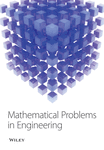A New Numerical Technique for Solving Volterra Integral Equations Using Chebyshev Spectral Method
Abstract
In this work, we propose a new method for solving Volterra integral equations. The technique is based on the Chebyshev spectral collocation method. The application of the proposed method leads Volterra integral equation to a system of algebraic equations that are easy to solve. Some examples are presented and compared with some methods in the literature to illustrate the ability of this technique. The results demonstrate that the new method is more efficient, convergent, and accurate to the exact solution.
1. Introduction
Many mathematical formulations of physical phenomena contain integral equations; these equations arise in many fields including biology, economics engineering, and medicine; for more details, see [1–4]. Finding solutions of linear or nonlinear Volterra integral equations is highly interesting for researchers and scientists in this field and there are available studies to find analytical or numerical solutions for Volterra integral equations (see [5–8]). In fact, Volterra integral equations are usually difficult to solve analytically, so we resort to finding approximate solutions to the problems using numerical or analytical approximation methods. The main purpose of this work is to introduce a new method for solving Volterra integral equations that uses Chebyshev spectral collocation method. Chebyshev spectral collocation methods have been applied successfully in different areas of sciences and engineering because of their ability to give highly accurate solutions of single or system of boundary value problems [9–13]. Chebyshev spectral methods are defined everywhere in the computational domain. Therefore, it is easy to compute high accurate values of a considered function at any point of the domain.
In the proposed method, we introduce a new integral transformation that is the replacement of an integral term in the Volterra integral equation by Chebyshev spectral differential matrix of known elements. The advantages of this approach over the standard same approaches are as follows: (i) the current technique suggests a standard way of choosing the auxiliary linear operator of the integral equation which is the main motivation behind the selection of the current algorithm whereas the other methods are choosing a linear operator to be simple in order to ensure that the integral or integrodifferential equations can be easily integrated and (ii) this algorithm transforms the integral equation(s) into a system of linear algebraic equations which is easier and faster to solve when compared to a system of integral equations. One of the disadvantages of this method is that it cannot be applied directly to the nonlinear integral equations; therefore, we need first to linearized the nonlinear integral equation using any available method such as the successive linearization method [14–17]. The applicability, accuracy, and reliability of the proposed method are confirmed by solving the various Volterra integral equations.
This paper is organized as follows: in Section 2, we introduce a description of the proposed method. In Section 3, the proposed method is implemented in some cases. The numerical results are discussed and investigated in Section 4. Finally, the paper is concluded in Section 5.
2. Description of the Method
Now, according to equations (7) and (10), we introduce the following transformation.
2.1. Definition
The existence and uniqueness of the linear transformation L defined in (12) depend on the existence and uniqueness of the inverse of matrix . In linear algebra, if A is a square matrix of size N × N, then (i) A is invertible if and only if rank (A) = N and (ii) if A is invertible, then its inverse is unique [22]. We applied this theorem to all square matrices to show that these matrices are invertible. In Figure 1, we display all the sizes of the matrices of sizes (N + 1) × (N + 1) against the corresponding ranks for 1 ≤ N ≤ 200. We notice that, from Figure 1, the rank of the matrix is equal to its size for all those values of N; that is, the matrix is invertible and consequently the inverse is unique.
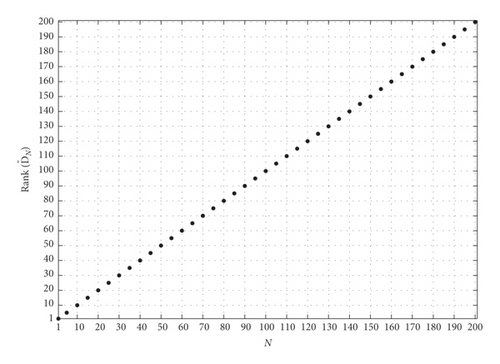
The general idea underpinning the use of the proposed method is the replacement of a linear Volterra integral equation by a system of linear algebraic equations that replace the integral part in the integral equation by the introduced integral transformation. The obtained linear algebraic equations can easily be solved with the help of symbolic computation software such as Maple, Mathematica, MATLAB, and other symbolic computer packages.
3. Numerical Examples
To illustrate the effectiveness and accuracy of the proposed technique in the present work, several examples are carried out in this section.
Example 1. Consider the following Volterra integral equation:
The exact solution is u(x) = −xex. According to (14), we have
To apply the proposed method to this test problem, we rewrite equation (19) in the following system of linear equations:
Thus, the final solution is obtained as
Example 2. Consider the following Volterra–Fredholm integral equation [23]:
Applying the proposed method to this problem, equation (23), we obtain the system of linear equations:
Thus, the final solution of the Volterra–Fredholm integral equation (22) is obtained as
Example 3. Consider the following system of linear Volterra integral equations [24]:
Now, converting the system above into a system of linear algebraic equations using the proposed method gives
Example 4. Consider the following quadratic nonlinear Volterra integral equation [25]:
For solving the nonlinear Volterra integral equation (33), we first use the successive linearization method (SLM) [14–17] to linearize the nonlinear integral equation (33). The SLM was recently introduced as an efficient linearization algorithm and robust method for solving boundary value problems. The procedure of the SLM is based on transforming the governing nonlinear equation into an iterative scheme made up of linear equations which is subsequently solved using the proposed method. In applying the SLM, we assume that the solution of (33) is obtained by
The linearized integral equation to be solved is obtained by substituting equation (34) in integral equation (33) and deleting the nonlinear terms. Thus, the linearized equation is expressed as
Example 5. Consider the following system of nonlinear Volterra integral equations [26, 27]:
Substituting (41) into (40) gives the linearized form
The suitable initial guesses for u0(x) and g0(x) are u0(x) = sin x − x and g0(x) = cos x − (sin2 x/2). Applying the proposed method on (42) gives the following m th approximations of the linear system of equations:
Thus, the final solution of the integral equations (40) for u(x) and g(x) is obtained as
4. Results and Discussion
Table 1 gives a comparison between the absolute errors of the present results and the Adomian Decomposition Method (ADM) at different iterations at selected nodes for Example 1. A striking feature of the proposed method is that a high level of accuracy is achieved at the first order of approximation than the ADM, for example, whereas the proposed method gives the exact value at only one iteration for the 14th digits. This is because the proposed method selects all the terms as linear operator.
| x | ADM iterations | Current results | |||
|---|---|---|---|---|---|
| 1st iteration | 2nd iteration | 3rd iteration | 4th iteration | 1st iteration | |
| 0 | 0 | 0 | 0 | 0 | 0 |
| 0.25 | 7.214e − 005 | 5.318e − 007 | 2.960e − 009 | 1.323e − 011 | 1.665e − 015 |
| 0.50 | 1.385e − 003 | 2.931e − 005 | 4.719e − 007 | 6.123e − 009 | 3.220e − 015 |
| 0.75 | 6.417e − 003 | 2.226e − 004 | 5.924e − 006 | 1.276e − 007 | 7.105e − 015 |
| 1.00 | 1.679e − 002 | 7.669e − 004 | 2.710e − 005 | 7.781e − 007 | 1.421e − 014 |
| 1.25 | 3.241e − 002 | 1.743e − 003 | 7.312e − 005 | 2.503e − 006 | 2.665e − 015 |
| 1.50 | 5.201e − 002 | 3.087e − 003 | 1.443e − 004 | 5.520e − 006 | 7.994e − 015 |
| 1.75 | 7.398e − 002 | 4.664e − 003 | 2.334e − 004 | 9.594e − 006 | 3.730e − 014 |
| 2.00 | 9.688e − 002 | 6.334e − 003 | 3.312e − 004 | 1.427e − 005 | 7.461e − 014 |
Table 2 shows a comparison between the results obtained by the current method and Shifted Chebyshev Collocation (SCC) method reported by Youssri and Hafez [23]; both methods have been applied to the Volterra–Fredholm integral equation (Example 2). It is noticed that accurate results with errors of order up to eight digits are observed using the proposed method while the SCC method is accurate up to six digits when applied to this example. Also, we notice that increasing the values of N leads to improvement in the accuracy of the solution using the SCC method whereas increasing the values of N does not affect the improvement in the accuracy of the solution using the proposed method.
| Youssri and Hafez [23] | Current method | |||
|---|---|---|---|---|
| x | N = 8 | N = 12 | N = 16 | |
| 0.1 | 2.96e − 003 | 5.97e − 004 | 3.02e − 005 | 7.30e − 009 |
| 0.2 | 8.79e − 004 | 5.75e − 004 | 3.00e − 004 | 2.30e − 009 |
| 0.3 | 7.10e − 004 | 3.63e − 004 | 1.33e − 004 | 2.70e − 009 |
| 0.4 | 9.59e − 004 | 1.64e − 004 | 4.62e − 005 | 7.81e − 009 |
| 0.5 | 1.75e − 005 | 6.72e − 006 | 3.24e − 006 | 1.31e − 008 |
| 0.6 | 7.12e − 004 | 1.31e − 004 | 2.19e − 005 | 1.87e − 008 |
| 0.7 | 2.48e − 004 | 1.43e − 004 | 6.51e − 005 | 2.49e − 008 |
| 0.8 | 1.87e − 004 | 1.75e − 004 | 6.74e − 005 | 3.19e − 008 |
| 0.9 | 4.93e − 004 | 4.87e − 005 | 9.79e − 006 | 4.02e − 008 |
| 1.0 | 5.12e − 004 | 1.71e − 004 | 7.71e − 005 | 5.03e − 008 |
In Table 3, we present the numerical results of the absolute errors uE(x) and gE(x) for u(x) and g(x), respectively, at selected nodes obtained by the proposed method, the Bernstein Polynomials Expansion (BPE) method [24], the Artificial Neural Network (ANN) method [24], and the Trapezoidal Quadrature Rule (TQR) method [28] for Example 3. It is remarkable to note that accurate results with errors of order up to sixteen digits are obtained using the proposed method while the BPE, ANN, and TQR methods are accurate up to only two, five, and two digits, respectively. This indicates that the proposed method converges much faster than the BPE, ANN, and TQR methods. Table 4 shows the maximum absolute errors uE(x) and gE(x) for u(x) and g(x), respectively, obtained by the proposed method using different values of N. The maximum absolute errors are very small for small values of N. Also, increasing the number of nodes (increasing N) does not result in a significant improvement in the accuracy of the current approximation. We also note that the present method is computationally fast as accurate results are generated in a fraction of a second. In Figure 2, a convergence analysis graph for Example 3 is presented. Figure 2 presents a variation of the error norm at various values of nodes (N). It can be seen that the values of nodes start from N = 10 to converge fully. The accuracy of the method does not improve when increasing grid points N.
| x = 1/2r | BPE method | ANN method | TQR method | Presented results |
|---|---|---|---|---|
| uE(x) | ||||
| r = 1 | 2.66e − 005 | 1.160e − 002 | 8.320e − 003 | 5.551e − 017 |
| r = 2 | 5.85e − 005 | 4.300e − 003 | 2.140e − 002 | 5.551e − 017 |
| r = 3 | 8.55e − 005 | 2.040e − 003 | 3.010e − 002 | 6.106e − 016 |
| r = 4 | 6.14e − 005 | 1.730e − 003 | 3.910e − 002 | 5.551e − 017 |
| r = 5 | 3.89e − 005 | 8.010e − 004 | 1.120e − 001 | 7.355e − 016 |
| r = 6 | 2.12e − 005 | 6.230e − 004 | 3.620e − 001 | 4.823e − 016 |
| r = 7 | 1.11e − 005 | 5.370e − 004 | 8.540e − 002 | 1.422e − 016 |
| r = 8 | 5.70e − 006 | 4.950e − 004 | 6.370e − 002 | 3.209e − 017 |
| r = 9 | 2.90e − 006 | 4.750e − 004 | 8.640e − 002 | 4.597e − 017 |
| gE(x) | ||||
| r = 1 | 4.92e − 005 | 9.280e − 004 | 8.070e − 003 | 2.220e − 016 |
| r = 2 | 1.37e − 005 | 1.480e − 03 | 4.810e − 003 | 2.220e − 016 |
| r = 3 | 2.04e − 005 | 4.430e − 003 | 3.710e − 002 | 2.220e − 016 |
| r = 4 | 4.11e − 005 | 5.910e − 003 | 3.160e − 002 | 6.661e − 016 |
| r = 5 | 9.44e − 005 | 7.940e − 003 | 4.240e − 001 | 4.441e − 016 |
| r = 6 | 5.17e − 005 | 1.940e − 002 | 2.800e − 001 | 0 |
| r = 7 | 2.71e − 005 | 4.130e − 002 | 1.780e − 001 | 4.441e − 016 |
| r = 8 | 1.38e − 005 | 6.890e − 002 | 7.070e − 002 | 0 |
| r = 9 | 7.01e − 006 | 9.400e − 002 | 9.040e − 003 | 0 |
| N | uE(x) | gE(x) | CPU time (sec) |
|---|---|---|---|
| 10 | 5.961e − 013 | 6.817e − 013 | 0.044 |
| 15 | 3.109e − 015 | 3.997e − 015 | 0.004 |
| 20 | 3.886e − 015 | 3.997e − 015 | 0.001 |
| 30 | 2.776e − 015 | 3.997e − 015 | 0.002 |
| 60 | 9.104e − 015 | 1.288e − 014 | 0.008 |
| 100 | 9.215e − 015 | 1.110e − 014 | 0.021 |
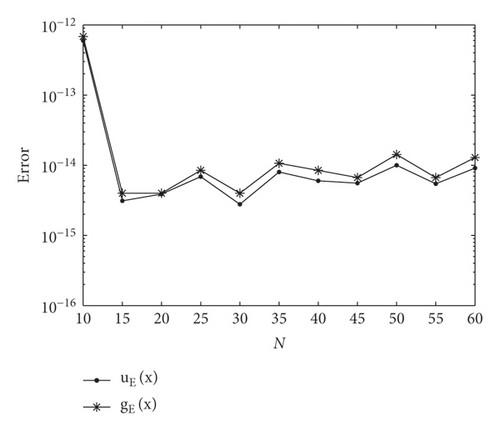
In Table 5, we have compared between the errors of present results for Example 4 corresponding to different values of collocation points N and those obtained by Maleknejad’s method (MAL) reported in [29] and Mean Value Theorem (MVT) reported in [25]. It can be seen that the present method converges rapidly compared to the MAL and MVT for this example. Full convergence to the 7 decimal places’ accurate results reported by MAL and MVT is achieved for the values N = 50 and N = 100 while high convergence is achieved to the 16 decimal places’ accurate results for the present method for all values of N ≥ 12. Table 6 shows the maximum absolute errors of u(x) for Example 4 at different orders of approximation at selected nodes. The maximum absolute errors are generally very small. A high level of accuracy is achieved at very low orders of approximation. We remark that increasing the number of nodes (i.e., increasing N) does not result in a significant improvement in the accuracy of the approximation. Figure 3 displays the errors against the iterations of the solution for Example 4 when N is fixed at 20. From Figure 3, it can be seen that the current solution rapidly converges, but the accuracy does not improve after 7 iterations.
| N | MAT | MVT | Present method |
|---|---|---|---|
| 5 | — | — | 7.287e − 008 |
| 12 | — | — | 8.882e − 016 |
| 15 | — | — | 4.441e − 016 |
| 50 | 2.435e − 007 | 1.669e − 007 | 8.882e − 016 |
| 100 | 1.166e − 007 | 3.057e − 008 | 4.441e − 016 |
| N | 1st iteration | 2nd iteration | 3rd iteration | 4th iteration |
|---|---|---|---|---|
| 10 | 4.849e − 006 | 1.483e − 013 | 1.741e − 013 | 1.741e − 013 |
| 12 | 4.849e − 006 | 2.842e − 014 | 8.882e − 016 | 8.882e − 016 |
| 14 | 4.849e − 006 | 2.753e − 014 | 4.441e − 016 | 4.441e − 016 |
| 16 | 4.849e − 006 | 2.709e − 014 | 4.441e − 016 | 4.441e − 016 |
| 20 | 4.849e − 006 | 2.753e − 014 | 4.441e − 016 | 4.441e − 016 |
| CPU time (sec) | 0.037166 | 0.037443 | 0.037711 | 0.037975 |
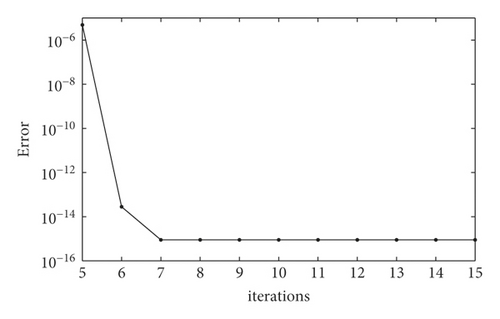
In Table 7, we have compared between the errors of present results for Example 5 corresponding to different values of x and those obtained by Single-Term Walsh Series (STWS) reported in [26] and Homotopy Perturbation Method (HPM) reported in [27]. Table 7 indicates that 15 decimal places’ accurate results are obtained using the present technique for large values of x while only 2 and 6 decimal places’ accurate results are obtained using HPM and STWS, respectively. It is interesting to note from Table 7 that when x increases, this would lead to a decrease in the absolute error for HPM and STWS, while increasing x does not result in a decrease in the accuracy of the current approximation. This shows that the present method is more efficient than the method of STWS and HPM. Table 8 shows the maximum absolute errors uE(x) and gE(x) of the present method at different orders of approximation for different values of N for Example 5. It can be seen that the maximum absolute errors are very small and further decrease with an increase in the order of the solution. Also, a large increase in the number of nodes (increasing N) does not result in a significant improvement in the accuracy of the present solution. In Figure 4, we display the absolute errors of u(x) and g(x) against collocation points N between the present results of Example 5 at the fifth iteration. From Figure 4, it is clear that the present method rapidly converges, and also, we notice that the accuracy does not improve for N > 13.
| x | Errors in HPM [26] | Errors in STWS [27] | Errors in present method | |||
|---|---|---|---|---|---|---|
| u(x) | g(x) | u(x) | g(x) | u(x) | g(x) | |
| 0.1 | 1.10e − 007 | 2.40e − 007 | 1.67e − 006 | 8.31e − 008 | 1.04e − 015 | 6.66e − 016 |
| 0.2 | 3.97e − 006 | 1.09e − 005 | 3.32e − 006 | 3.30e − 007 | 5.55e − 016 | 5.55e − 016 |
| 0.3 | 5.55e − 005 | 1.19e − 004 | 4.97e − 006 | 7.33e − 007 | 3.61e − 015 | 3.33e − 016 |
| 0.4 | 3.81e − 004 | 6.27e − 004 | 6.59e − 006 | 1.28e − 006 | 2.61e − 015 | 2.22e − 016 |
| 0.5 | 1.64e − 003 | 2.20e − 003 | 8.20e − 006 | 1.95e − 006 | 7.22e − 016 | 2.22e − 016 |
| 0.6 | 5.20e − 003 | 5.96e − 003 | 9.79e − 006 | 2.73e − 006 | 7.77e − 016 | 4.44e − 016 |
| 0.7 | 1.32e − 002 | 1.33e − 002 | 1.14e − 005 | 3.58e − 006 | 5.11e − 015 | 1.11e − 015 |
| 0.8 | 2.86e − 002 | 2.59e − 002 | 1.30e − 005 | 4.47e − 006 | 4.33e − 015 | 1.55e − 015 |
| 0.9 | 5.41e − 002 | 4.49e − 002 | 1.47e − 005 | 5.36e − 006 | 4.66e − 015 | 1.67e − 015 |
| 1.0 | 9.21e − 002 | 7.07e − 002 | 1.65e − 005 | 6.22e − 006 | 3.33e − 015 | 1.78e − 015 |
| N | 3rd iteration | 4th iteration | 5th iteration | 6th iteration |
|---|---|---|---|---|
| uE(x) | ||||
| 10 | 6.024e − 005 | 1.028e − 010 | 1.145e − 010 | 1.145e − 010 |
| 12 | 6.027e − 005 | 1.278e − 010 | 1.841e − 013 | 1.834e − 013 |
| 14 | 6.026e − 005 | 1.311e − 010 | 4.663e − 015 | 4.774e − 015 |
| 18 | 6.026e − 005 | 1.317e − 010 | 4.885e − 015 | 5.218e − 015 |
| 22 | 6.026e − 005 | 1.317e − 010 | 5.967e − 015 | 6.189e − 015 |
| CPU time (sec) | 0.002304 | 0.002993 | 0.003679 | 0.004365 |
| gE(x) | ||||
| 10 | 1.938e − 005 | 6.811e − 011 | 7.369e − 011 | 7.369e − 011 |
| 12 | 1.939e − 005 | 3.733e − 011 | 1.179e − 013 | 1.177e − 013 |
| 14 | 1.939e − 005 | 3.901e − 011 | 1.665e − 015 | 1.776e − 015 |
| 18 | 1.939e − 005 | 3.929e − 011 | 1.332e − 015 | 1.332e − 015 |
| 22 | 1.939e − 005 | 3.929e − 011 | 1.110e − 015 | 1.110e − 015 |
| CPU time (sec) | 0.002329 | 0.003601 | 0.004878 | 0.006196 |
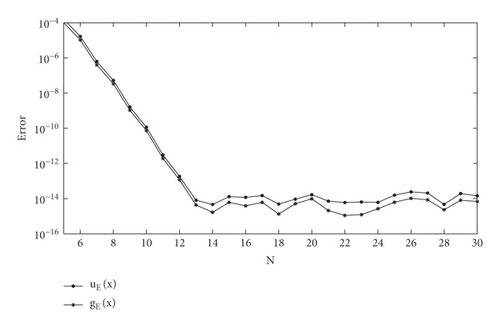
5. Conclusion
- (1)
The method is more flexible than other numerical methods such as BPE, ANN, TQR, STWS, HPM, MAT, and MVT since it allows us to choose the integral operators in the integral equations in terms of the Chebyshev spectral collocation differentiation matrix.
- (2)
The proposed method is highly accurate and efficient, converges rapidly, and is sufficient to give good agreement with the exact solution.
- (3)
The suggested technique does not depend on the number of collocation points N and it requires a few numbers of collocation points to achieve high accuracy of results.
Finally, we note that the proposed method described above is a powerful method that is appropriate in solving Volterra integral equations and can be generalized for Volterra and Fredholm integral equations. In future, we intend to show that the proposed method can be extended to coupled Volterra integrodifferential equations.
Conflicts of Interest
The author declares that there are no conflicts of interest.
Open Research
Data Availability
No data were used to support this study.



